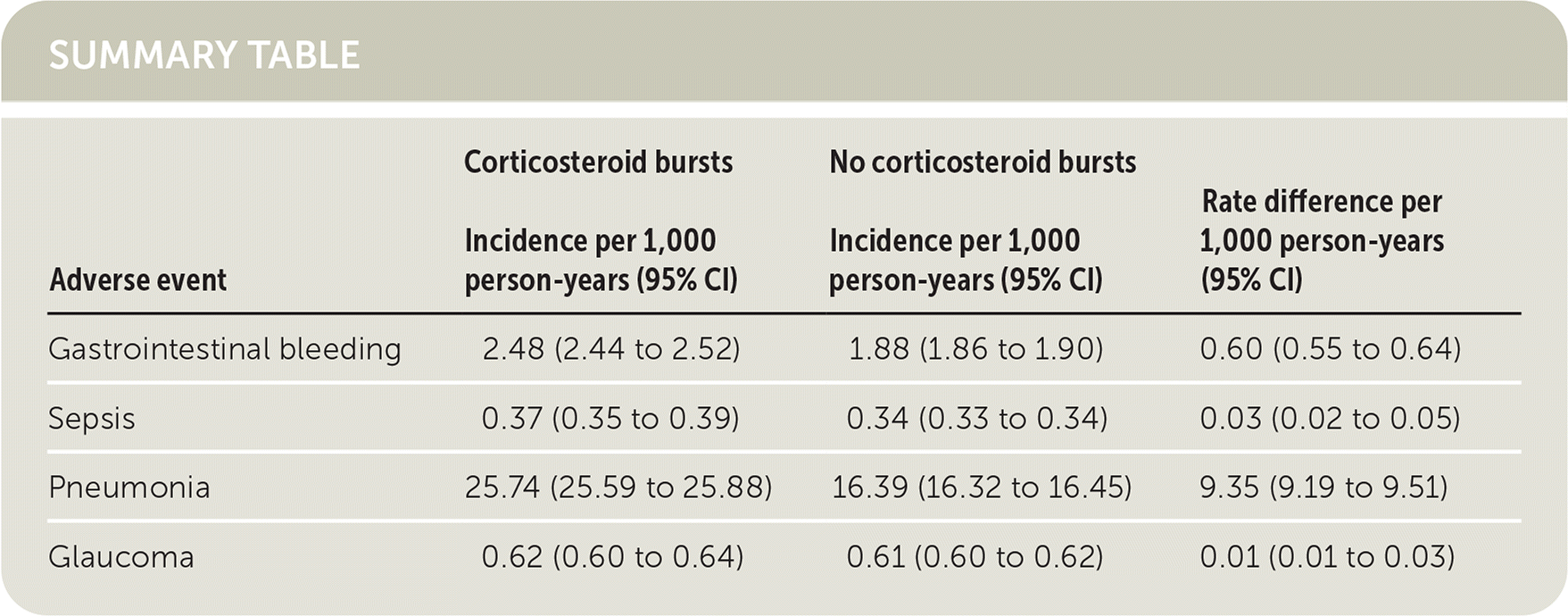
Am Fam Physician. 2022;105(1):94-95
Clinical Question
Are steroid bursts in children potentially harmful?
Bottom Line
Although corticosteroid bursts have potential for improving outcomes for many acute illnesses, this study shows that the potential harms are not trivial. (Level of Evidence = 3b)
Synopsis
Clinicians widely prescribe corticosteroid bursts to children for multiple indications, assuming that these short courses are harmless. The authors used the national database in Taiwan to conduct a self-controlled case series to evaluate the potential harms associated with a single burst of corticosteroids in children. The database covers 99% of the Taiwanese population and includes insurance claims and prescription data. From this database of more than 4.5 million children, the authors identified 1,897,858 children younger than 18 years who had one or more corticosteroid bursts of 14 days or less. Approximately 42% of all children in the database had at least one exposure to corticosteroid bursts. The gender distribution was roughly equal, and 91% had no comorbid conditions. The most common reasons for the bursts, accounting for 65% of the indications, included acute respiratory infections and allergic conditions. The authors subdivided children into those who received a single burst and those who had more than one burst. The baseline differences between the groups were comparable. The authors comprised data from 90 days before the start and 90 days after the completion of each burst to assemble each case study. As summarized in the table, gastrointestinal bleeding, sepsis, pneumonia, and glaucoma occurred more frequently in children treated with corticosteroid bursts than in untreated children. With the exception of glaucoma, the adverse events occurred more frequently during the first 30 days after treatment and were slightly elevated afterward.

| Adverse event | Corticosteroid bursts | No corticosteroid bursts | |
|---|---|---|---|
| Incidence per 1,000 person-years (95% CI) | Incidence per 1,000 person-years (95% CI) | Rate difference per 1,000 person-years (95% CI) | |
| Gastrointestinal bleeding | 2.48 (2.44 to 2.52) | 1.88 (1.86 to 1.90) | 0.60 (0.55 to 0.64) |
| Sepsis | 0.37 (0.35 to 0.39) | 0.34 (0.33 to 0.34) | 0.03 (0.02 to 0.05) |
| Pneumonia | 25.74 (25.59 to 25.88) | 16.39 (16.32 to 16.45) | 9.35 (9.19 to 9.51) |
| Glaucoma | 0.62 (0.60 to 0.64) | 0.61 (0.60 to 0.62) | 0.01 (0.01 to 0.03) |
Study design: Case series
Funding source: Government
Setting: Population-based
Reference: Yao TC, Wang JY, Chang SM, et al. Association of oral corticosteroid bursts with severe adverse events in children [published correction appears in JAMA Pediatr. 2021;175(7):751]. JAMA Pediatr. 2021;175(7):723–729.
